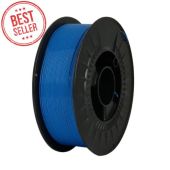ASA Drying Temperature: How to Properly Dry Filament for Best Prints
Understanding ASA and Moisture
ASA (Acrylic Styrene Acrylonitrile) is widely used in 3D printing for its durability and excellent resistance to UV light, moisture, and weather conditions. However, like most thermoplastics used in fused deposition modeling (FDM), ASA is hygroscopic. This means it absorbs moisture from the air over time, which negatively affects the printing process and final product quality.
When ASA absorbs moisture, water molecules interact with the polymer chains, breaking them apart. This leads to several printing issues, such as poor surface quality, reduced layer adhesion, stringing, bubbling, and compromised mechanical properties.
Drying ASA filament before printing is critical to maintaining consistent print quality, minimizing defects, and ensuring the finished product retains ASA's mechanical properties.
Ideal ASA Drying Temperature and Process
The recommended temperature for this filament is 80–90°C. This range is effective for removing moisture without risking the deformation or degradation of the filament.
Drying should typically last 4 to 6 hours, depending on the ambient humidity and how long the filament was exposed to air. For filaments heavily saturated with moisture, extending the drying time up to 8 hours may be necessary.
Using a filament dryer with accurate temperature controls is ideal. Alternatively, a conventional oven can be used, but it requires careful monitoring to prevent overheating. Using an external thermometer helps maintain the correct temperature range and avoid accidental filament damage.
Consequences of Printing ASA Without Proper Drying
Printing with undried ASA filament leads to visible and structural issues. Bubbling or popping sounds may occur during extrusion as moisture turns into steam. Surface imperfections such as roughness, pitting, or a fuzzy finish can appear, making the printed object aesthetically unappealing. Poor layer adhesion weakens the printed part, and the tensile and impact strength of the object may be significantly reduced. Dimensional inaccuracies can also occur, compromising the fit and functionality of parts. These issues can render the final prints unsuitable for structural applications, particularly for parts exposed to stress or outdoor conditions.
Storing ASA Filament to Prevent Moisture Absorption
To minimize the need for frequent drying, ASA filament should be kept in airtight containers combined with desiccant packs. Vacuum-sealed storage bags designed for filament protection are also highly effective. Whenever possible, storing filaments in low-humidity environments helps prevent moisture absorption. Humidity-controlled dry boxes, especially those with built-in hygrometers and active dehumidifiers, offer additional long-term protection.
Printing ASA After Drying
Once properly dried, ASA filament delivers excellent print results. Typical printing parameters include:
- Extruder temperature: 235°C to 255°C
- Bed temperature: 80°C to 100°C
- Enclosure: Recommended to reduce warping
- Build surface: Glass, PEI sheets, Kapton tape, or adhesive sprays
- Cooling fan: Off or low speed
Properly dried filament ensures smooth extrusion, stronger layer bonding, and high dimensional accuracy while preserving the material's inherent strength and resistance properties.
Comparison with Other Filaments and Drying Needs
ASA shares similarities with ABS but offers better UV stability, making it ideal for outdoor applications. Compared to PLA, ASA requires higher drying and printing temperatures but provides much better weather resistance and mechanical durability. In contrast, PETG and nylon exhibit different sensitivities to moisture and require specific drying conditions.
| Filament | Drying Temperature | Typical Drying Time |
|---|---|---|
| ASA | 80–90°C | 4–8 hours |
| PLA | 40–45°C | 4–6 hours |
| ABS | 80°C | 4–8 hours |
| PETG | 65–70°C | 4–6 hours |
| Nylon | 80°C | 6–8 hours |
These guidelines highlight the relative drying requirements across popular filament types, showing that while ASA requires care, it remains manageable for most users.
Best Practices for Drying ASA Filament
- Preheat the drying device before inserting the filament.
- Use an external oven thermometer to verify temperature accuracy.
- Do not leave filament unattended in an oven due to temperature fluctuations.
- After drying, immediately seal the filament in a moisture-resistant container.
- Weigh the spool before and after drying to estimate moisture loss (optional).
Pro Tip: A 0.5–1% weight loss after drying indicates significant moisture removal — a good sign your ASA is print-ready.
Advantages of ASA for Outdoor and Industrial Applications
The durability of ASA extends well beyond UV resistance. Its ability to withstand exposure to moisture, rain, and fluctuating temperatures makes it well-suited for outdoor environments. Outdoor signs, garden tools, automotive parts, protective housings, and patio furniture all benefit from these properties. The material maintains structural integrity under mechanical stress and resists cracking or deformation even after prolonged use. Additionally, its chemical resistance makes it suitable for industrial environments where exposure to various substances is common.
Surface finishing options enhance its appeal further. Through processes like acetone vapor smoothing, ASA prints can achieve a glossy, professional appearance without compromising mechanical properties. This finishing capability allows users to produce both functional and aesthetically refined parts.
Industrial Adoption and Long-Term Performance
In many industries, ASA has become a material of choice not only for prototyping but also for producing functional end-use parts. Automotive manufacturers rely on it for external body components and trim pieces that need to withstand outdoor exposure. Similarly, manufacturers of outdoor electrical enclosures, agricultural equipment, and architectural elements frequently choose this material for its combined strength, durability, and weather tolerance.
Over extended periods, components produced from ASA show excellent dimensional stability. Unlike some polymers that become brittle or warped over time, ASA maintains its shape and functional properties even after years of service. This long-term reliability reduces the need for frequent part replacements, providing cost savings and operational efficiency in demanding applications.
About 3D Trček and Our Filament Solutions
At 3D Trček, we offer a wide selection of filaments, including ASA, PLA, PETG, TPU FLEX, ABS, PCTG, and more. We understand the importance of delivering high-quality materials tailored to meet professional and hobbyist 3D printing needs.
Our personal approach, short lead times, and expert advice ensure you receive the right material for your project. Explore our full range at 3D Trček.
; ?>) Shop ASA Filament
Shop ASA Filament


Please complete your information below to login.
Sign In
Create New Account